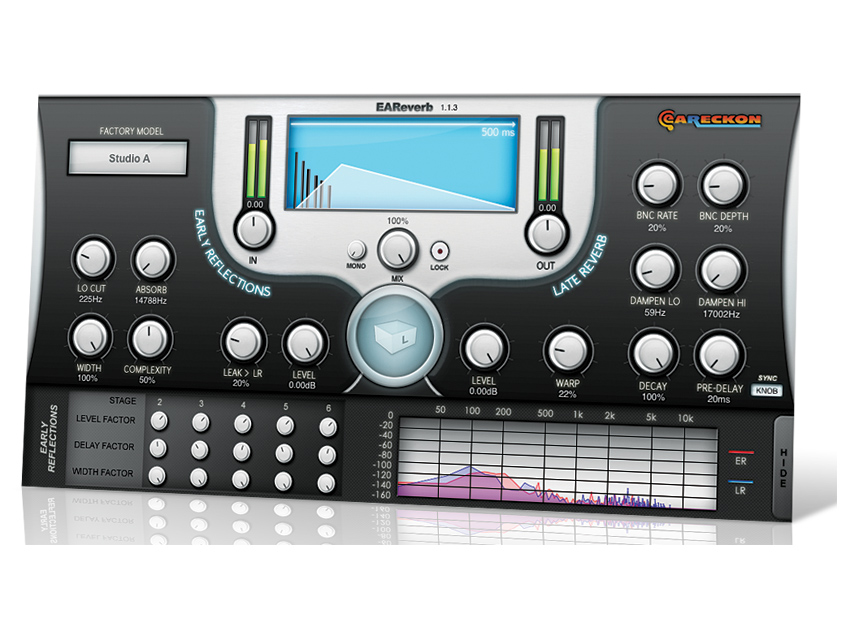MusicRadar Verdict
We've heard countless quality reverb plug-in, but EAReverb's natural sound and neat interface fully justify its existence.
Pros
- +
Very natural reverb. Affordably priced. Straightforward interface. Advanced control over early reflections.
Cons
- -
Slightly short on presets. Will benefit from upcoming larger rooms. Not capable of very bright reverbs.
MusicRadar's got your back
eaReckon's latest release, EAReverb, is a reverb plug-in for both Mac (VST/AU) and PC (VST). It's designed to deliver what eaReckon is calling an "earthy" algorithmic sound.
The controls are laid out very simply, with early reflections to the left and 'late reverb' (ie, the tail) to the right. Room size is selected in the middle.
"It does live up to its promise of delivering incredibly natural spaces."
Further 'advanced' early reflection parameters and the frequency analyser display are hidden beneath the Workshop panel at the bottom.
Although the layout is very clear, the terminology used can be rather, er, individual. For example, the early reflection Width controls the delay time between reflections (rather than stereo width, as you might expect), while the Complexity setting controls their density and character. Even so, with a typical 'reverb graph' in the main window, it soon becomes pretty obvious what's what.
Further options include late reverb pre-delay with host tempo sync (1/4, 1/8 and 1/16), Warp (a complex multi-LFO modulator for the late reverb), input signal width control (via the Mono knob), and Bnc Rate and Bnc Depth knobs, which enable level modulation ('bounce').
Although EAReverb clearly delineates early and late reverb processing, you can use the Leakage knob to feed the former into the latter.
The plug-in uses a single natural-sounding algorithm, but it's been tailored to provide seven differently sized spaces, labelled from XXS to XXL. Selecting one of these spaces affects not only a number of underlying parameters, but also impacts the ranges of the user controls.
Super-size me
EAReverb features an integrated preset browser and just 28 factory patches. These include both typical spaces (Concert Hall and Studio), as well as application-specific patches (Acoustic Guitar Room and Vocal Room). They're fine, but we'd have liked to have seen plenty more.
We tried EAReverb on a number of typical sources and we have to say that it does live up to its promise of delivering incredibly natural spaces.
We felt that it excelled at smaller spaces: with the three smallest (XXS, XS and S), it was possible to get anything from subtle ambience to width enhancement with minimal reverb tail. This made it great for adding subtle width and space to beats, voice and acoustic instruments.
Live drums benefit from both the smaller and larger spaces, and in this case, EAReverb 'sits' really well in the mix. You can always use the Workshop and modulation options to create more synthetic, artificial effects.
On the downside, the largest room size (XXL) has a maximum decay (RT60) of roughly 3.8 seconds, which isn't that huge. It's fine for most uses, but if you like creating impressive effects or just fancy a longer 'verb, it's not possible.
Thankfully, eaReckon is developing larger spaces with decay times of up to a cavernous 30 seconds - they sent us some audio clips to check out, and it all sounds great. The plan is to add at least one of these in a future update.
One more caveat is that EAReverb isn't much use for bright, artificially splashy/sparkly reverbs, presumably due to its deliberately natural-sounding approach. Minor gripes aside, however, this is a highly useable plug-in at an attractive price.
Computer Music magazine is the world’s best selling publication dedicated solely to making great music with your Mac or PC computer. Each issue it brings its lucky readers the best in cutting-edge tutorials, need-to-know, expert software reviews and even all the tools you actually need to make great music today, courtesy of our legendary CM Plugin Suite.
“We were arguing a lot and we were miserable”: How Green Day exceeded expectations with their most ambitious song
"There’s plenty for us guitarists to learn – and ‘less is more’ is the overriding lesson": how to play like George Harrison on The Beatles' Abbey Road
“They didn’t like his bikini underwear”: Prince’s support sets for the The Rolling Stones in 1981 are remembered as disastrous, but guitarist Dez Dickerson says that the the crowd reaction wasn’t as bad as people think











